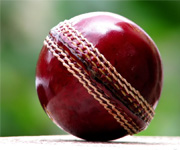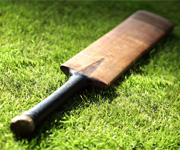|
|

|
|

There are certain rules regarding the measurement of the ball, bat, pitch, wicket and the creases. There is a boundary for the playing area. The boundary is marked either by a white line, a rope laid on the ground or a fence. Sometimes flags and posts are used instead of a boundary line.

A cricket ball consists of cork covered by leather. In Test Cricket, the red colored ball is used while in ODI and T20, the white colored ball is used. The ball weight must not be less than 155.9gms and not more than 163gms and the circumference of the ball must be in between 22.4cm and 22.9cm for Men's cricket and for Woman's cricket the weight should be in between 139.976gms and 143.519gms and the circumference of the ball must be in between 21.082cm and 22.606cm. Most widely used brand of balls are S.G., Duke and Kukkabura.

Cricket bats are made of Willow, a naturally fibrous wood. The cricket bat has three distinct parts the blade, the handle and the grip. Blade is the main part of a cricket bat with which you hit the ball. The handle sticks out from the top of the blade and is wrapped with twine for strength. The grip is a rubber covering for the handle. The dimensions prescribed by MCC for a wooden bat is 38 inch long excluding the handle, and 4.25 inch wide.

Each wicket is 22.80cm in width and consist of three wooden stumps with two wooden bails on the top. The wickets should be pitched opposite and parallel to each other at a distance of 20.12m between the center of the two middle stump. The stumps stand 70cm tall and each bail is 11.1cm in length.
The pitch is at the center of the field. It is the area of the ground between the bowling creases one on either side and it is 3.04m in width and 17.68m in length. The pitch shall not be changed during a match unless it becomes unfit for play.

The bowling crease is marked in line with the stumps at each end and is 2.64m in length. The popping crease which is the back edge of the crease marking, is in front of and parallel with the bowling crease. The back edge of the crease is 1.22m from the center of the stumps and extended to a minimum of 1.83m on either side of the line of the wicket. The return crease is marked at each end of the bowling crease at right angles to it and extend forward to join the popping crease and a minimum of 1.22m behind the wicket.
|
|